
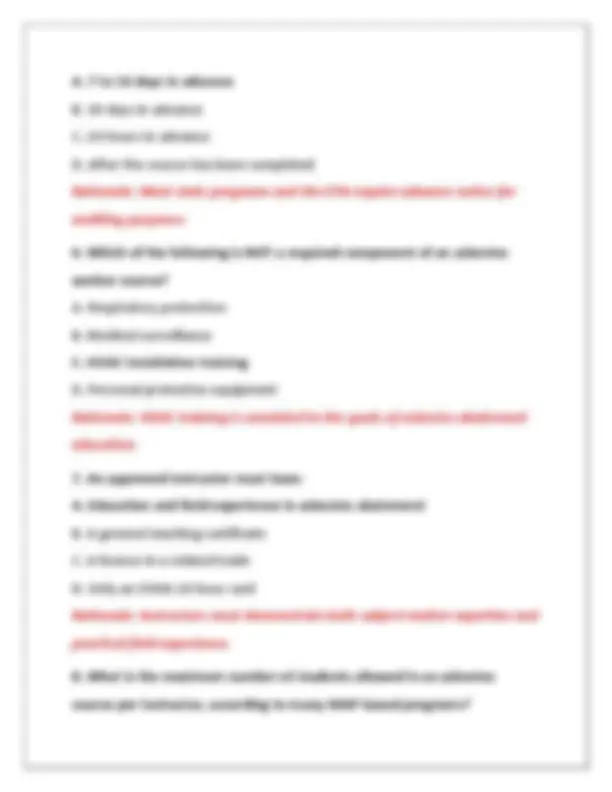
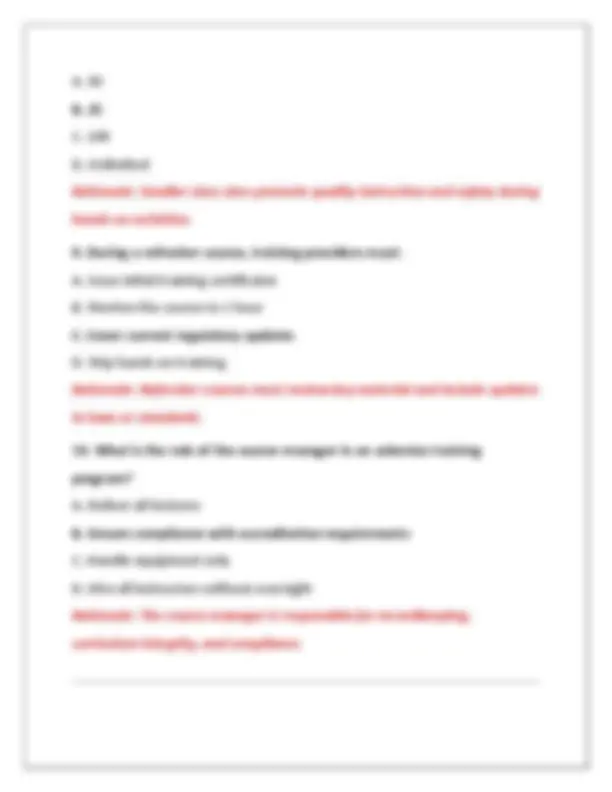
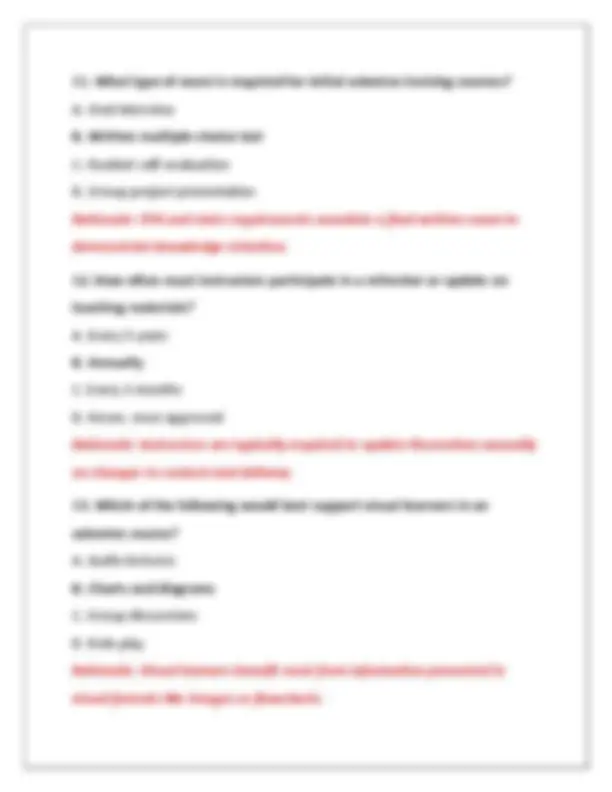
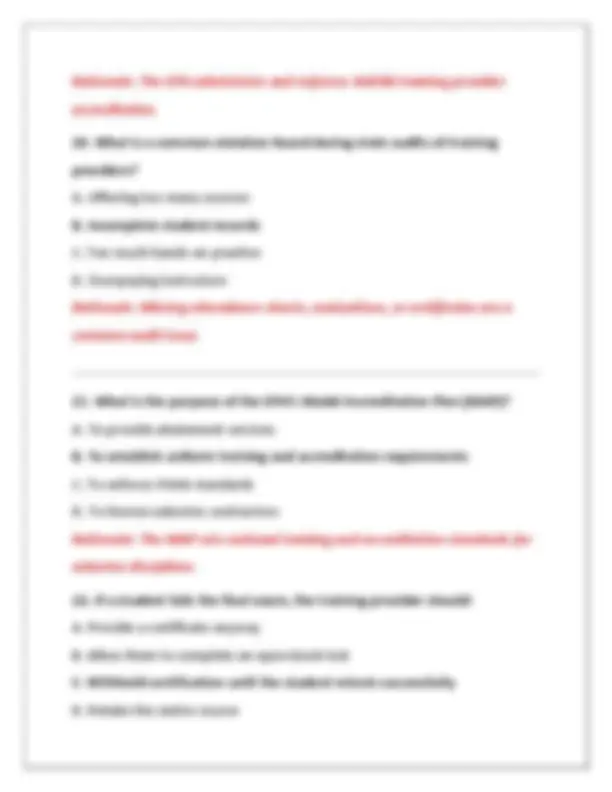
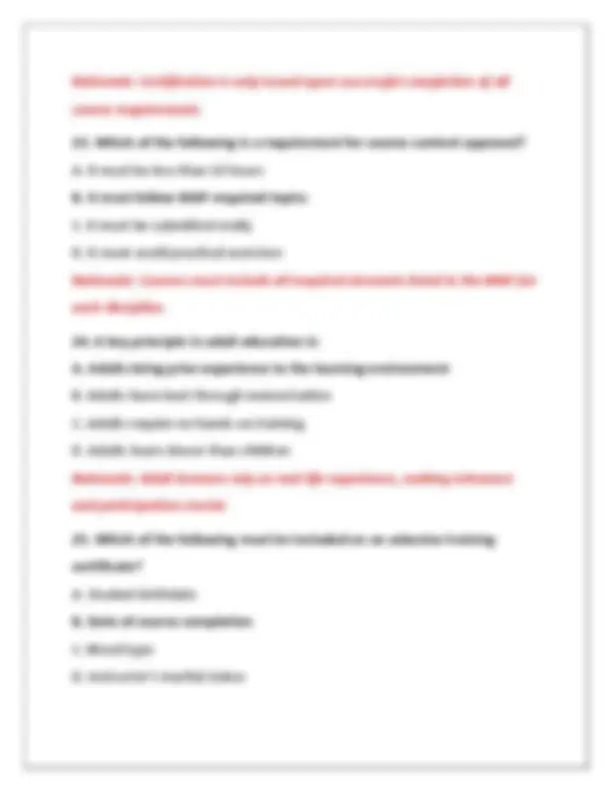
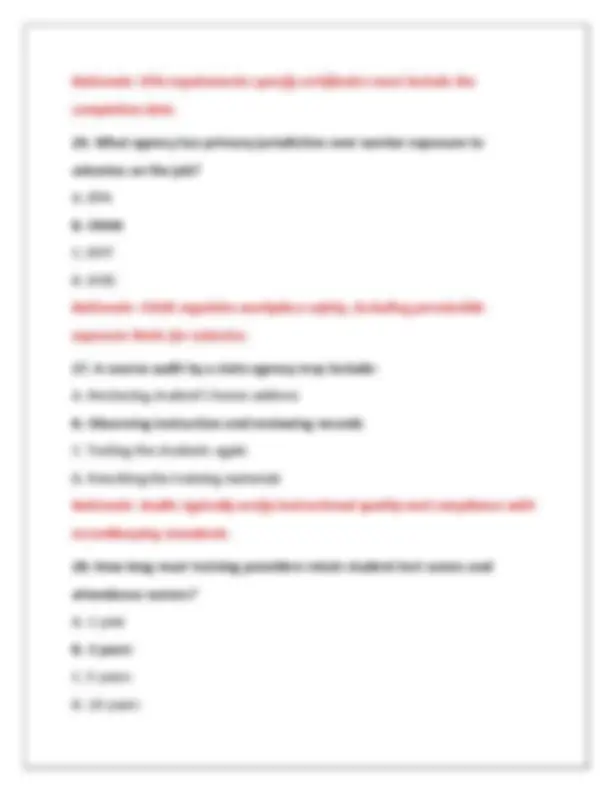
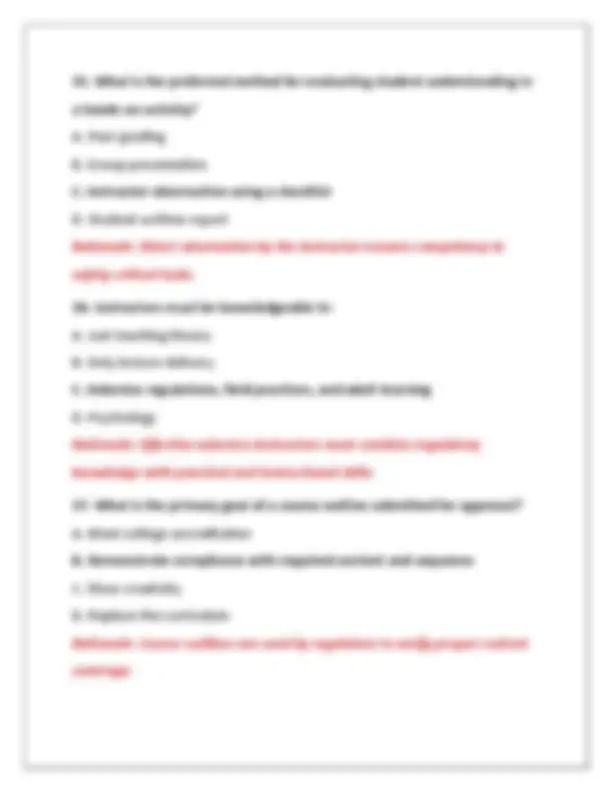
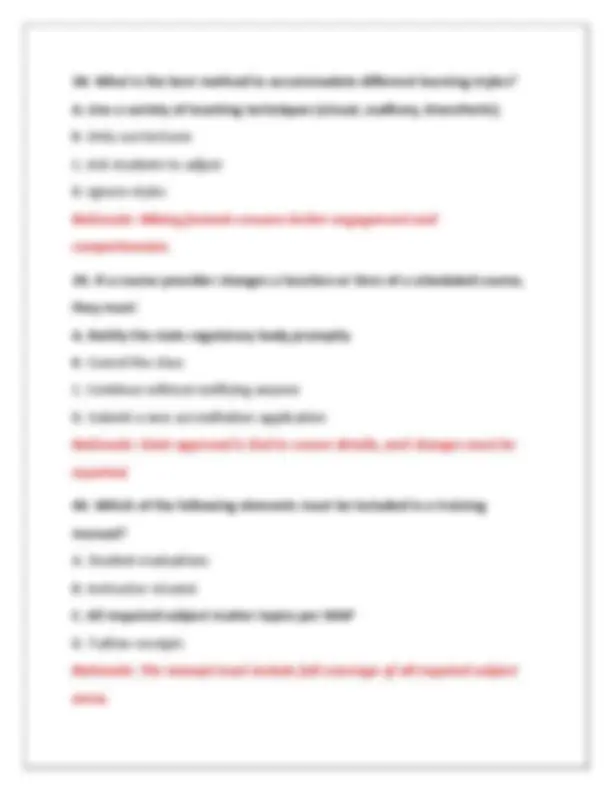
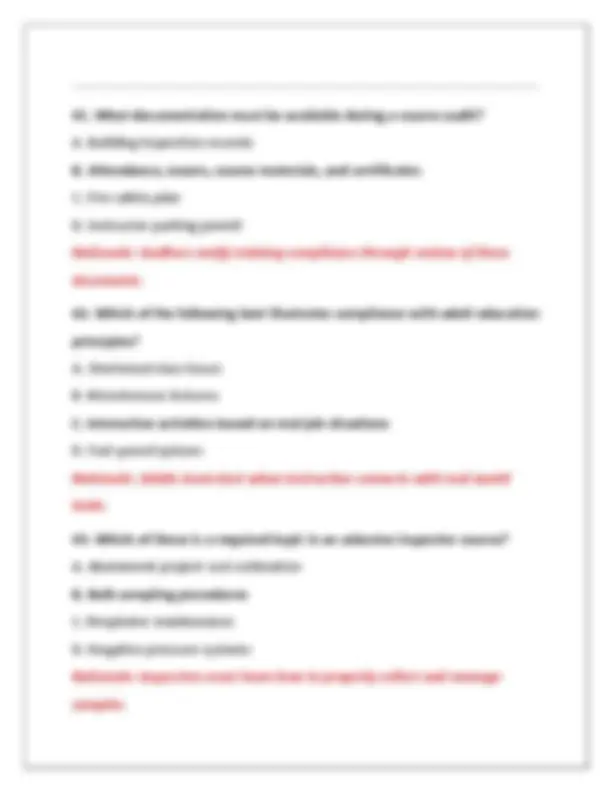
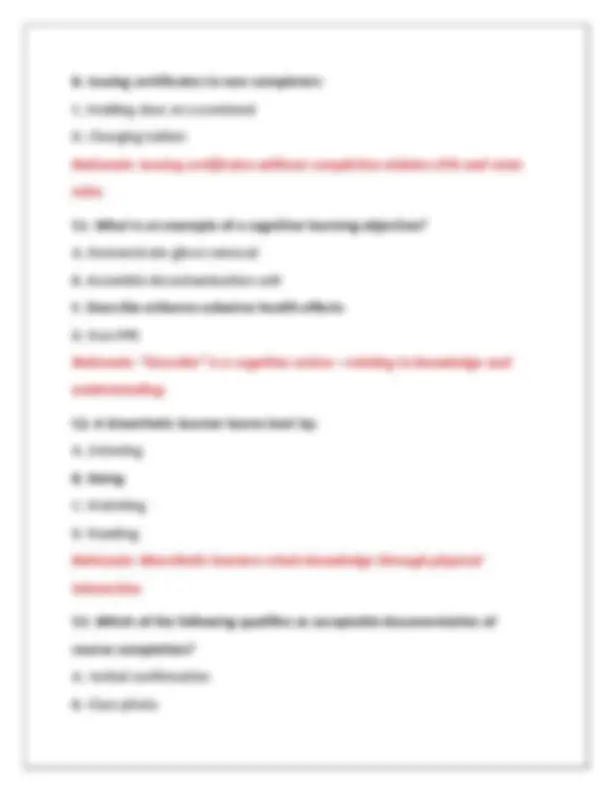
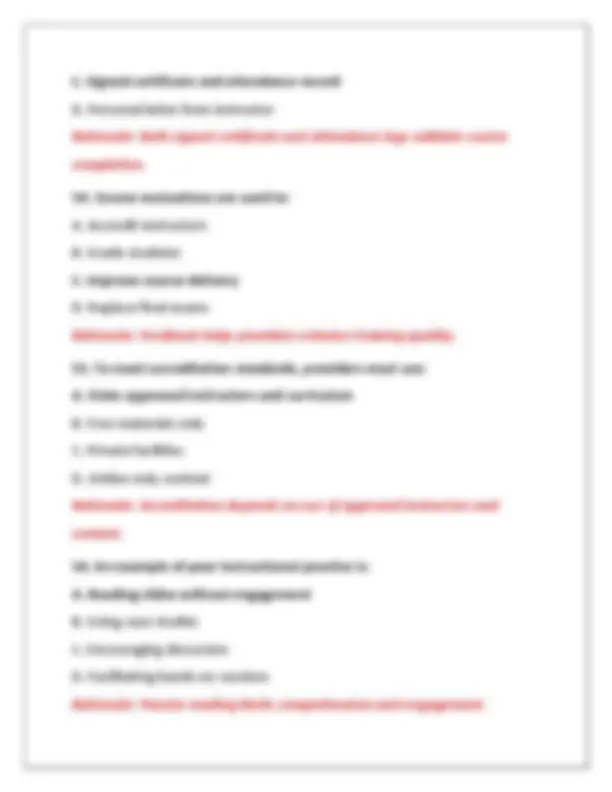
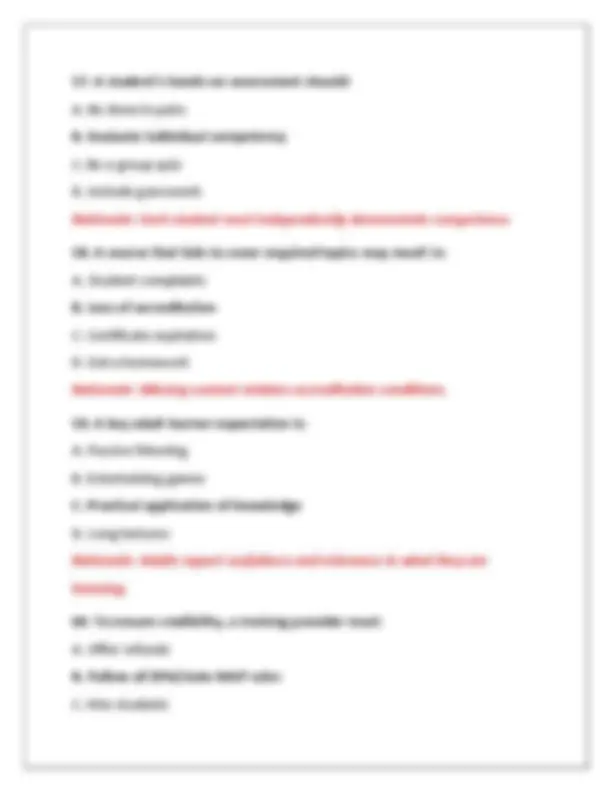
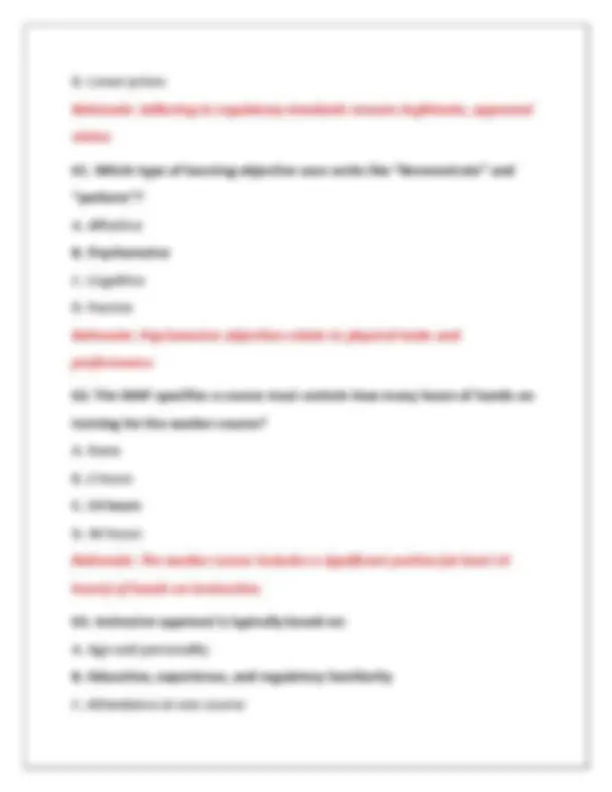
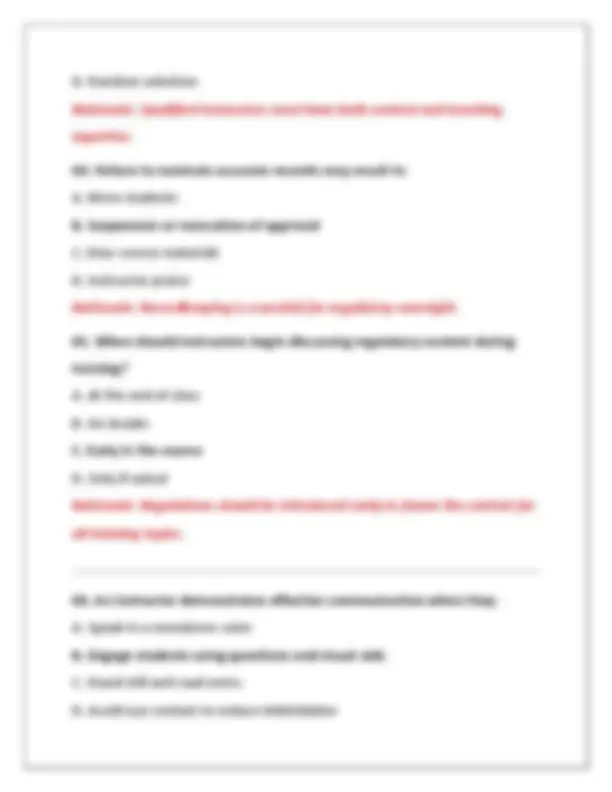
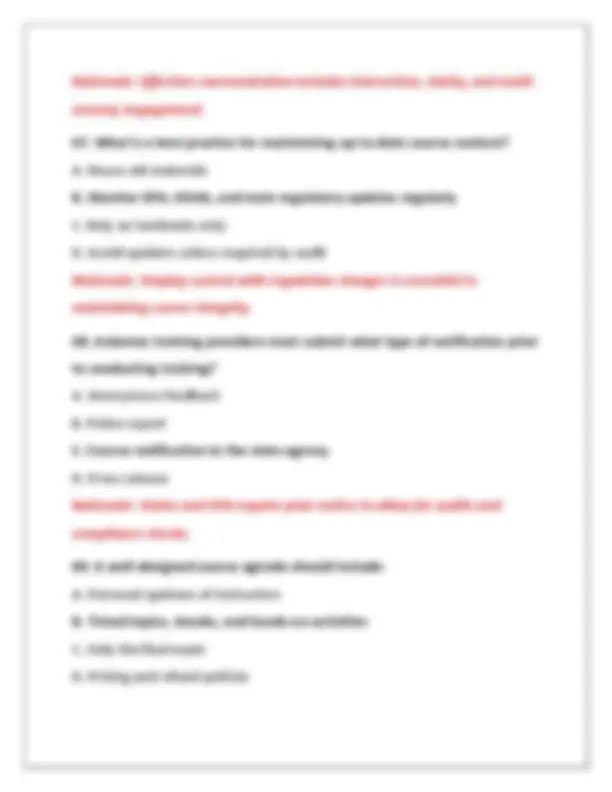
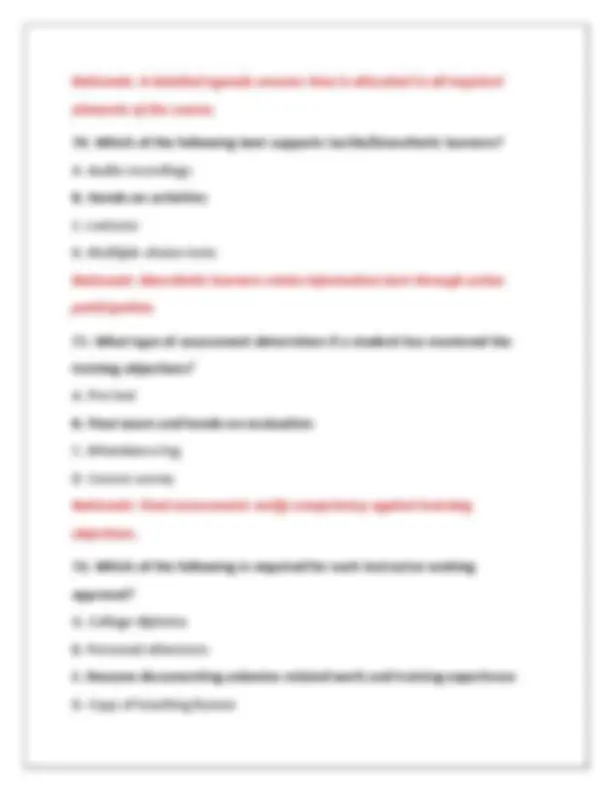
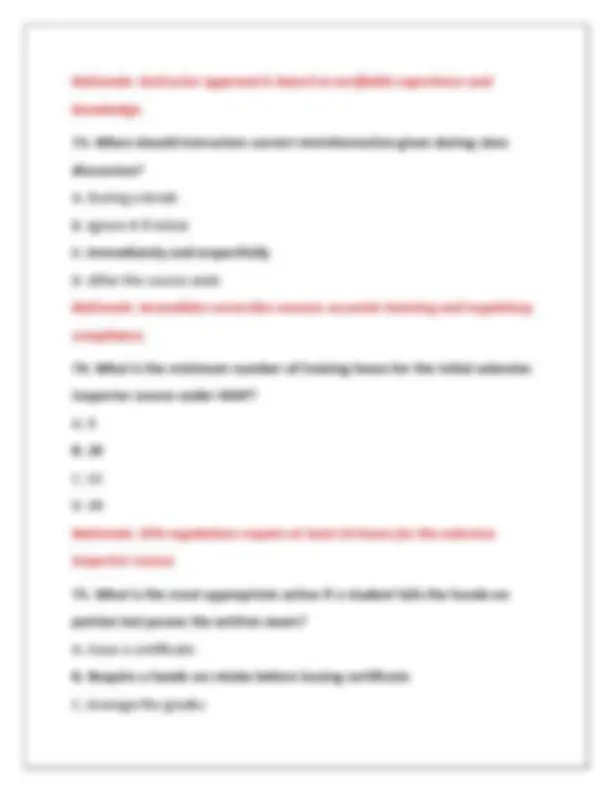
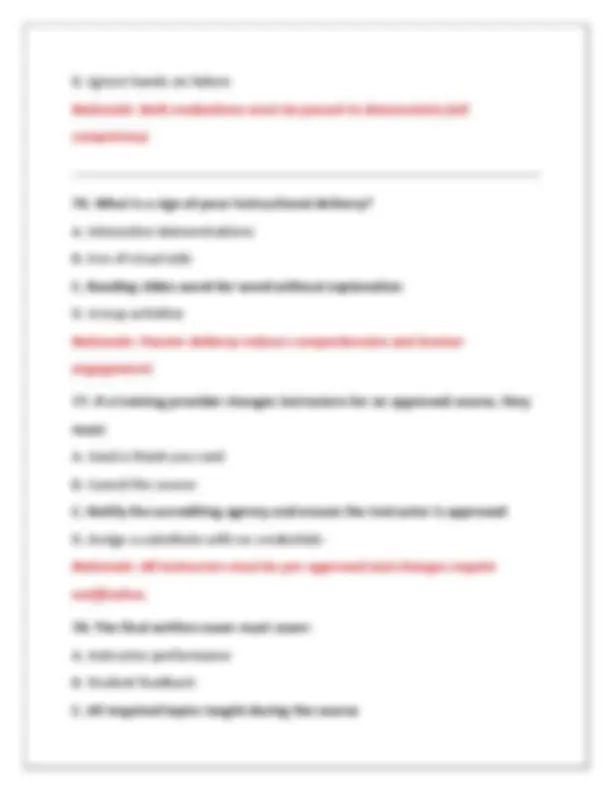
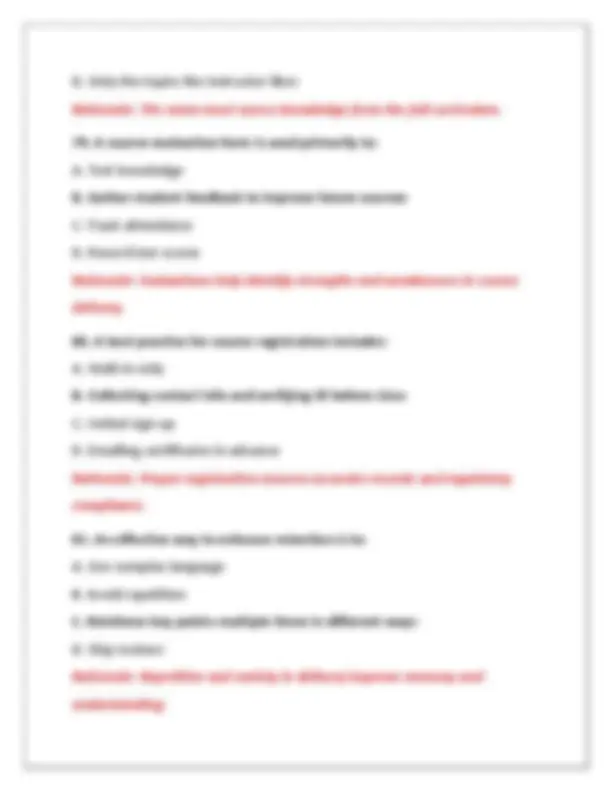
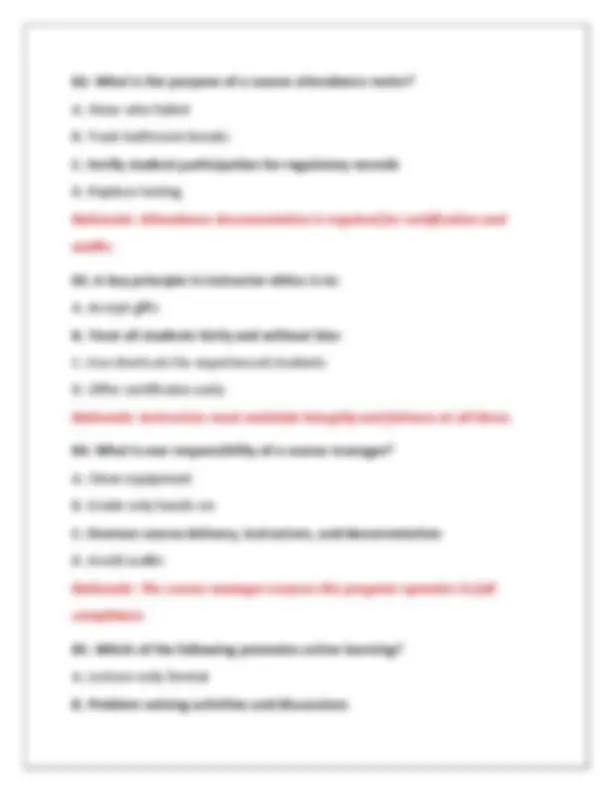
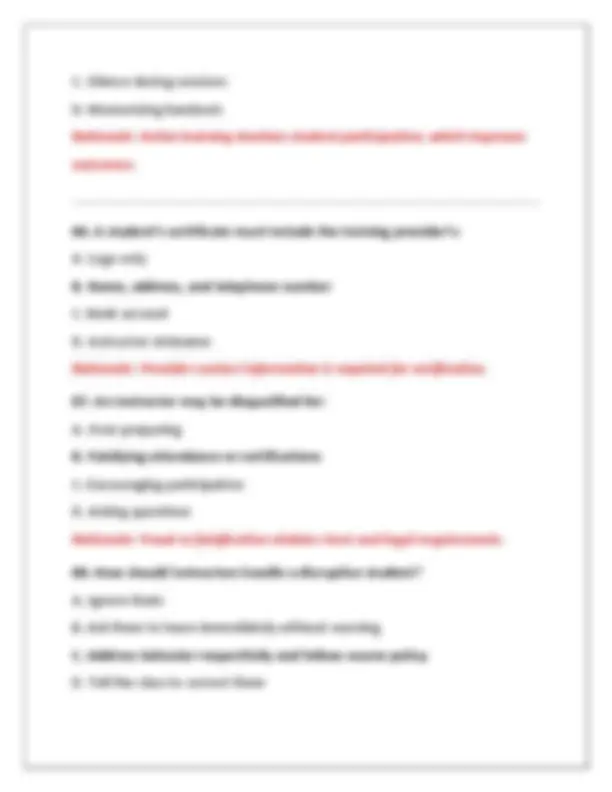
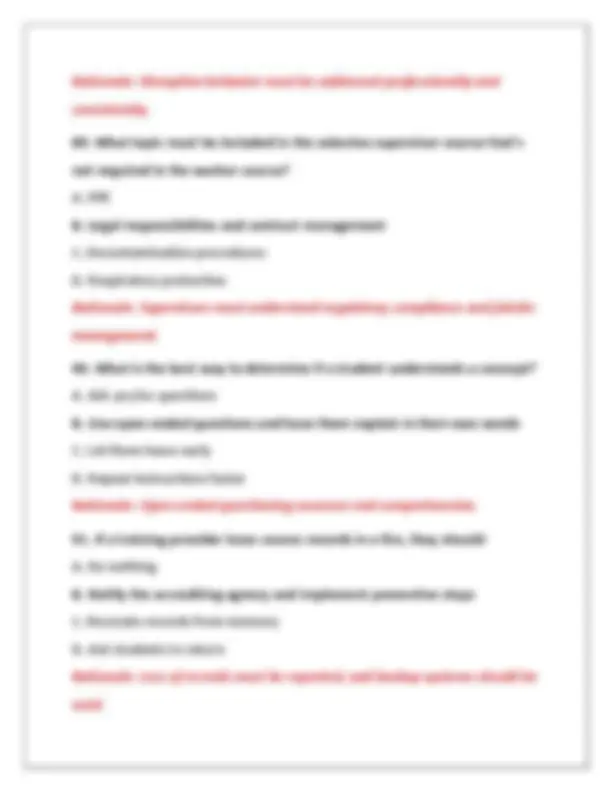
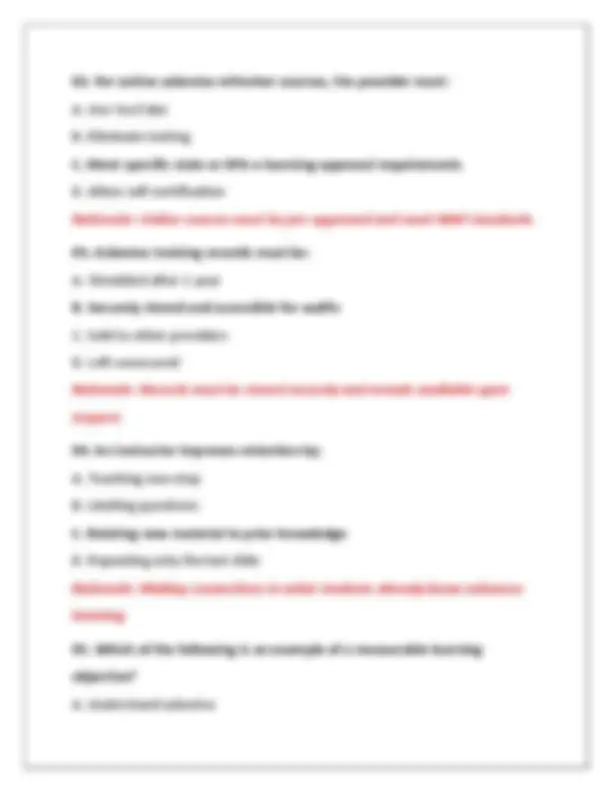
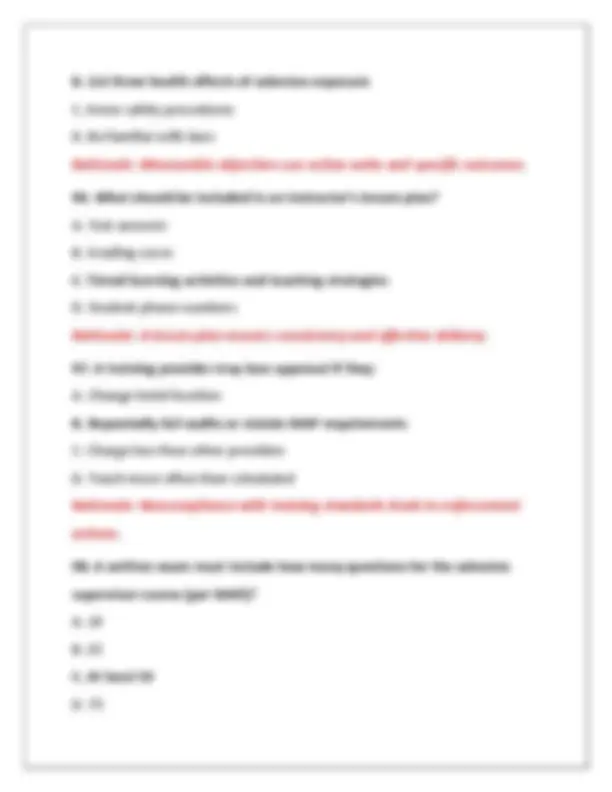
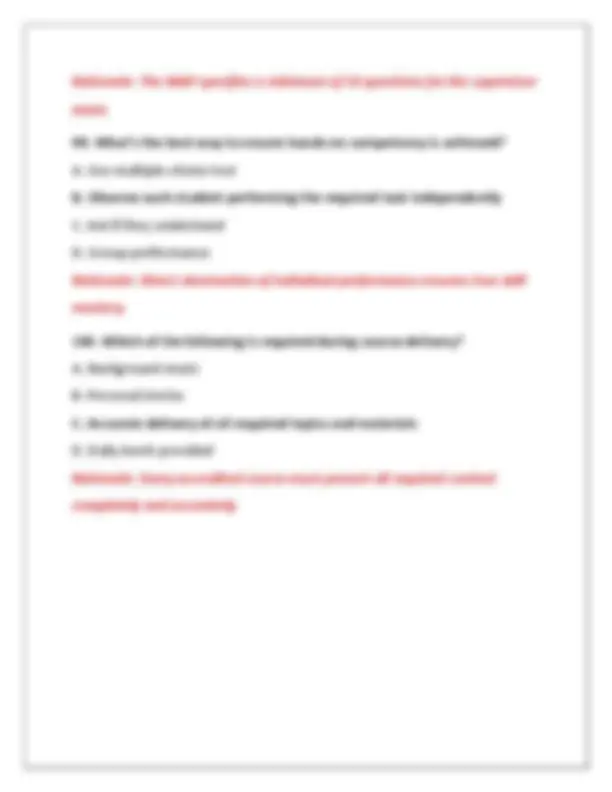


Study with the several resources on Docsity

Earn points by helping other students or get them with a premium plan


Prepare for your exams
Study with the several resources on Docsity

Earn points to download
Earn points by helping other students or get them with a premium plan
Community
Ask the community for help and clear up your study doubts
Discover the best universities in your country according to Docsity users
Free resources
Download our free guides on studying techniques, anxiety management strategies, and thesis advice from Docsity tutors
Asbestos Training Provider/Instructor Approval Exam 1 QUESTIONS AND CORRECT ANSWERS (VERIFIED ANSWERS) PLUS RATIONALES 2025 Q&A | INSTANT DOWNLOAD PDF
Typology: Exams
1 / 33

This page cannot be seen from the preview
Don't miss anything!


























1. Which federal regulation sets the standard for asbestos training provider accreditation? A. 40 CFR Part 763, Subpart E, Appendix C B. 29 CFR 1926. C. 49 CFR 172. D. 40 CFR Part 61, Subpart M Rationale: This is the specific EPA regulation governing the Model Accreditation Plan (MAP) for asbestos training providers. 2. How long must an asbestos training provider retain course records? A. 1 year
B. 3 years C. 5 years D. Indefinitely Rationale: According to EPA MAP requirements, records must be kept for a minimum of 3 years.
3. What is the primary purpose of a hands-on assessment during asbestos training? A. To reduce overall training time B. To evaluate skill competency C. To provide entertainment during training D. To complete attendance requirements Rationale: Hands-on assessments measure whether students can competently perform critical abatement tasks. 4. According to adult learning theory, adult learners are most motivated by: A. Fear of failing B. Relevance to job performance C. Social interaction D. Instructor authority Rationale: Adults are goal-oriented and want learning to be immediately applicable to their jobs. 5. A training provider must notify the state regulatory agency of upcoming courses at least:
D. Unlimited Rationale: Smaller class sizes promote quality instruction and safety during hands-on activities.
9. During a refresher course, training providers must: A. Issue initial training certificates B. Shorten the course to 1 hour C. Cover current regulatory updates D. Skip hands-on training Rationale: Refresher courses must review key material and include updates to laws or standards. 10. What is the role of the course manager in an asbestos training program? A. Deliver all lectures B. Ensure compliance with accreditation requirements C. Handle equipment only D. Hire all instructors without oversight Rationale: The course manager is responsible for recordkeeping, curriculum integrity, and compliance.
11. What type of exam is required for initial asbestos training courses? A. Oral interview B. Written multiple-choice test C. Student self-evaluation D. Group project presentation Rationale: EPA and state requirements mandate a final written exam to demonstrate knowledge retention. 12. How often must instructors participate in a refresher or update on teaching materials? A. Every 5 years B. Annually C. Every 3 months D. Never, once approved Rationale: Instructors are typically required to update themselves annually on changes to content and delivery. 13. Which of the following would best support visual learners in an asbestos course? A. Audio lectures B. Charts and diagrams C. Group discussions D. Role play Rationale: Visual learners benefit most from information presented in visual formats like images or flowcharts.
Rationale: The EPA Model Accreditation Plan requires a minimum of 32 training hours.
17. What defines a "discipline" under the MAP regulation? A. Type of institution B. Student grade level C. Category of asbestos work (e.g., worker, inspector, supervisor) D. The course's difficulty Rationale: Each category of asbestos-related work is referred to as a discipline. 18. A valid training course must include which of the following evaluation methods? A. Peer grading B. Hands-on and written evaluations C. Instructor self-assessment D. Daily quizzes only Rationale: MAP requires both cognitive and performance-based assessments. 19. Which agency enforces training accreditation under AHERA? A. U.S. Environmental Protection Agency (EPA) B. Department of Education C. Department of Labor D. OSHA
Rationale: The EPA administers and enforces AHERA training provider accreditation.
20. What is a common violation found during state audits of training providers? A. Offering too many courses B. Incomplete student records C. Too much hands-on practice D. Overpaying instructors Rationale: Missing attendance sheets, evaluations, or certificates are a common audit issue. 21. What is the purpose of the EPA's Model Accreditation Plan (MAP)? A. To provide abatement services B. To establish uniform training and accreditation requirements C. To enforce OSHA standards D. To license asbestos contractors Rationale: The MAP sets national training and accreditation standards for asbestos disciplines. 22. If a student fails the final exam, the training provider should: A. Provide a certificate anyway B. Allow them to complete an open-book test C. Withhold certification until the student retests successfully D. Retake the entire course
Rationale: EPA requirements specify certificates must include the completion date.
26. What agency has primary jurisdiction over worker exposure to asbestos on the job? A. EPA B. OSHA C. DOT D. DOE Rationale: OSHA regulates workplace safety, including permissible exposure limits for asbestos. 27. A course audit by a state agency may include: A. Reviewing student's home address B. Observing instruction and reviewing records C. Testing the students again D. Rewriting the training materials Rationale: Audits typically verify instructional quality and compliance with recordkeeping standards. 28. How long must training providers retain student test scores and attendance rosters? A. 1 year B. 3 years C. 5 years D. 10 years
Rationale: The MAP and most state rules require at least 3 years of retention.
29. In an initial training course, what is the maximum number of students in a hands-on exercise per instructor? A. 30 B. 10 C. 25 D. 50 Rationale: Smaller groups during hands-on activities are critical for safety and effective supervision. 30. Which of the following best describes formative assessment? A. Ongoing checks for understanding during instruction B. Final exam at the end C. Certificate issuance D. State audit Rationale: Formative assessments are used throughout instruction to guide teaching and adjust delivery. 31. What is the EPA-required duration of an initial contractor/supervisor course? A. 24 hours B. 32 hours C. 40 hours
35. What is the preferred method for evaluating student understanding in a hands-on activity? A. Peer grading B. Group presentation C. Instructor observation using a checklist D. Student-written report Rationale: Direct observation by the instructor ensures competency in safety-critical tasks. 36. Instructors must be knowledgeable in: A. Just teaching theory B. Only lecture delivery C. Asbestos regulations, field practices, and adult learning D. Psychology Rationale: Effective asbestos instructors must combine regulatory knowledge with practical and instructional skills. 37. What is the primary goal of a course outline submitted for approval? A. Meet college accreditation B. Demonstrate compliance with required content and sequence C. Show creativity D. Replace the curriculum Rationale: Course outlines are used by regulators to verify proper content coverage.
38. What is the best method to accommodate different learning styles? A. Use a variety of teaching techniques (visual, auditory, kinesthetic) B. Only use lectures C. Ask students to adjust D. Ignore styles Rationale: Mixing formats ensures better engagement and comprehension. 39. If a course provider changes a location or time of a scheduled course, they must: A. Notify the state regulatory body promptly B. Cancel the class C. Continue without notifying anyone D. Submit a new accreditation application Rationale: State approval is tied to course details, and changes must be reported. 40. Which of the following elements must be included in a training manual? A. Student evaluations B. Instructor résumé C. All required subject matter topics per MAP D. Tuition receipts Rationale: The manual must include full coverage of all required subject areas.
44. What is the role of the hands-on component in training? A. Filler for course length B. Practical application of theoretical knowledge C. Optional entertainment D. Time for breaks Rationale: Hands-on ensures that learners can actually perform the required tasks. 45. To renew accreditation, providers must: A. Submit updates and meet all documentation and audit requirements B. Only send student evaluations C. Ask for a waiver D. Pay a fee without paperwork Rationale: Renewal requires a full submission verifying ongoing compliance. 46. Which record must be retained by the training provider? A. Lunch menu B. Final exam and score C. Student driver’s license D. Travel logs Rationale: The final exam and score document the student's successful completion.
47. What is the maximum time allowed to issue certificates after course completion? A. 30 days B. 2 weeks (typically) C. 3 months D. No time limit Rationale: Most states require prompt issuance, often within 14 days. 48. Who is responsible for ensuring only approved instructors teach accredited courses? A. The students B. The hotel hosting the class C. The training provider D. OSHA Rationale: Providers are accountable for the instructors they use. 49. If an instructor is found non-compliant, the provider must: A. Fire the students B. Remove the instructor and notify the regulator C. Ignore the situation D. Blame the agency Rationale: Instructors must meet qualifications; non-compliance must be addressed immediately. 50. Which of the following is considered unethical for a training provider? A. Teaching extra material
C. Signed certificate and attendance record D. Personal letter from instructor Rationale: Both signed certificate and attendance logs validate course completion.
54. Course evaluations are used to: A. Accredit instructors B. Grade students C. Improve course delivery D. Replace final exams Rationale: Feedback helps providers enhance training quality. 55. To meet accreditation standards, providers must use: A. State-approved instructors and curriculum B. Free materials only C. Private facilities D. Online-only content Rationale: Accreditation depends on use of approved instructors and content. 56. An example of poor instructional practice is: A. Reading slides without engagement B. Using case studies C. Encouraging discussion D. Facilitating hands-on sessions Rationale: Passive reading limits comprehension and engagement.
57. A student's hands-on assessment should: A. Be done in pairs B. Evaluate individual competency C. Be a group quiz D. Include guesswork Rationale: Each student must independently demonstrate competence. 58. A course that fails to cover required topics may result in: A. Student complaints B. Loss of accreditation C. Certificate expiration D. Extra homework Rationale: Missing content violates accreditation conditions. 59. A key adult learner expectation is: A. Passive listening B. Entertaining games C. Practical application of knowledge D. Long lectures Rationale: Adults expect usefulness and relevance in what they are learning. 60. To ensure credibility, a training provider must: A. Offer refunds B. Follow all EPA/state MAP rules C. Hire students